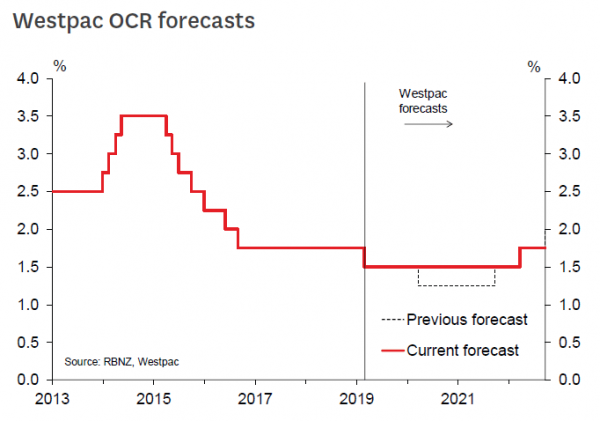- Today we are reaffirming our forecast that the RBNZ will keep the OCR on hold at 1.5% for the remainder of 2019.
- This is a finely balanced call. A follow-up cut is possible if the data weakens further.
- But as we said on April 3, we expect an economic pickup later this year to remove thoughts of another OCR cut.
- Previously, we thought that the introduction of capital gains tax (CGT) would prompt an OCR cut in 2020.
- But the Government has cancelled CGT. That, combined with low mortgage rates, has seen us shift to forecasting 7% house price inflation next year.
- Under such conditions, we no longer see a rationale for cutting the OCR in 2020.
- We are now forecasting no change in the OCR until mid-2022.
On April 3 this year we issued a forecast that the OCR would be cut to 1.5% this week, would remain at 1.5% throughout 2019, and would be cut again to 1.25% in mid-2020. The rationale was:
- The RBNZ had floated the idea of cutting the OCR, and it was starting to look as though inflation would struggle to reach 2% if the OCR was kept at 1.75%, so we thought an immediate cut was warranted.
- We expected the economy to pick up over the remainder of 2019 due to fiscal stimulus, a stabilisation in the global economy, and accelerating building activity. This would cancel any thought of a follow-up cut later in 2019.
- We thought a capital gains tax or similar policy would be legislated and campaigned on for the next election, causing weakness in the housing market and low business confidence during 2020. In turn, this would prompt the RBNZ to cut the OCR again at that time.
Now that the first leg of that thinking is in the past, scrutiny is turning to the second – will the RBNZ’s cut be a case of “one-and-done”, as we suggested a month ago, or will they cut again in 2019?
The new Monetary Policy Committee has shown that it is willing to act decisively and proactively, meaning another cut is certainly possible, depending on how the data evolves.
But we put the odds of a follow up cut at slightly less than 50%. We still think it is more likely that the RBNZ will leave the OCR at 1.5% for the remainder of the year.
The RBNZ itself is 50/50 on whether another OCR cut will be required, meaning some form of downside surprise would be required to actually prompt a cut. At this stage, we don’t think there is a high likelihood of that happening. The RBNZ is already braced for weak data in the near term – for example, it is forecasting 0.4% for March quarter GDP, lower than our forecast of 0.5%. Getting numbers that are south of the RBNZ’s downbeat near-term forecasts is not the most likely scenario.
Beyond the coming few months, our view remains that evidence of a strengthening economy will scotch any thought of cutting the OCR.
The global economy will be crucial to the RBNZ’s decisions. We think it is likely to stabilise this year, thanks to sharply lower interest rates and fiscal stimulus. Equity markets seem to agree, judging by the sharp rise in global share prices over the past few months.
Having confirmed our 2019 OCR forecast, we will take the opportunity to fine-tune our longer-term view. We are no longer forecasting an OCR cut in mid-2020.
The third leg of the reasoning laid out above was wrong. The Government has cancelled any possibility of a capital gains tax (CGT). There is no longer any reason to think the housing market is going to slow in 2020. Far from it. We now expect house price inflation to accelerate to 7% by mid-2020, due to the recent sharp drop in mortgage rates.
Our revised view that the housing market will accelerate over the coming year, rather than decelerate, has removed the rationale for forecasting an OCR cut in 2020.
We now expect the OCR to remain at 1.5% until mid-2022.














